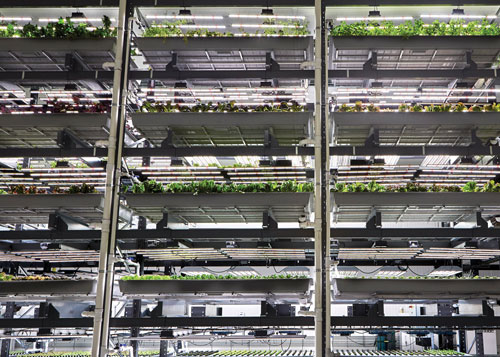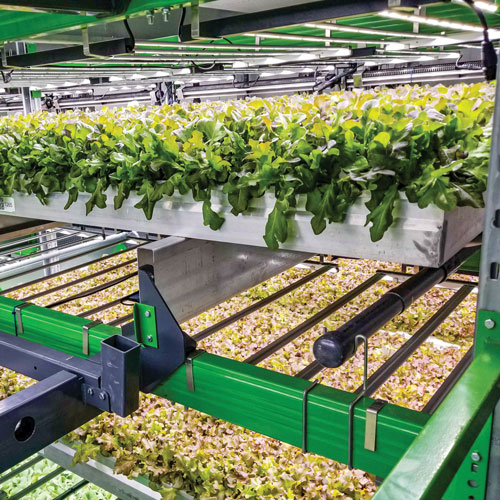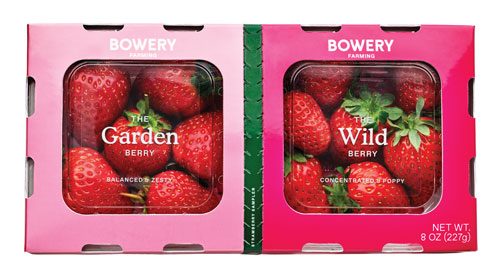5/1/2022
Farming for the Future
Jennifer Polanz

Vertical farming has always been positioned as the farm of the future. Bowery Farming, headquartered in Manhattan, and now with four operating farms and two more on the way, has taken the future of farming indoors to the next level.
We’ll get to the technical aspirations in a minute, but first, the inspiration behind Bowery, which started in 2015 when co-founder and CEO Irving Fain saw a problem in the way food was being
produced.
Pictured: The original Bowery location has been turned into the R&D Center of Excellence, where cultivars are developed for quality and taste, rather than yield and long-haul transportation.
“He was struck there hadn’t been the degree of technical innovation in this space that there was in other industries,” says Bowery Chief Commercial Officer Katie Seawell, who adds as Irving researched the problem, he saw vertical farming as a way to grow large amounts of food in an efficient way—if it was done correctly. “He wasn’t seeing an operating system that was really delivering on the promise of the efficiency and scale that vertical farming could deliver. The Bowery Operating System has always been a function of Bowery from the very beginning.”
That very beginning started with the first commercial farm in Kearny, New Jersey, which has now been repurposed into a research and development (R&D) facility. The second location, which they call Farm X, opened in 2021 next to the original and is a larger R&D facility designed to home in on the exact environments that create better-tasting produce.
 Pictured: The Nottingham, Maryland, facility built upon the beginnings in Kearny, New Jersey, and added more technology and automation.
Pictured: The Nottingham, Maryland, facility built upon the beginnings in Kearny, New Jersey, and added more technology and automation.
“Home to a first-of-its-kind in-house breeding program and research lab, Farm X enables us to accelerate the commercial timelines for bringing next generation crops to consumers, from strawberries and root vegetables to tomatoes, cucumbers and more,” Katie says. “Some of the latest innovations that have come out of Farm X include the new product line of our limited-edition Farmer’s Selection, which includes Mustard Frills, a green with a tingly start and wasabi-style finish.”
The next “vintage” farm was in Baltimore, in the Nottingham area, which was larger than the first two with more automation and technology.
“That is the proof of concept that we’ve then taken to the next farm that we’re opening in late March in Bethlehem, Pennsylvania,” Katie told me in February. That farm is the largest and most sophisticated Bowery operation to date.
The operating system controlling it all
The key to the Bowery kingdom is the Bowery Operating System, or the BoweryOS. It’s controlling every aspect of the process, from propagation to growing, harvesting and packing. The OS integrates sensors, vision systems, automation, technology and robotics to control the growing process—everything from the light recipes and nutrient mixes to controlling the environment and monitoring plant health.
“Through the growing cycle we’re constantly optimizing and tweaking the inputs into the recipe based on information from the BoweryOS,” Katie says. “It manages the workflow of the farm. If you could visualize a farm, we are stacking crops floor to ceiling.
“We are able to tell our farmers this cultivar needs this recipe. [The OS] puts it in the right growing position in the farm … moves it out of the growing room when it’s done and into the harvesting room, all through the BoweryOS.”
Each of the growing trays exists in its own microenvironment even though they’re stacked up within the farm. Each has a different recipe that maximizes the flavor, Katie notes. Another benefit to the system is complete transparency from the beginning, as each stage is tracked in the OS.
Learning as it goes
What does all that mean? As more farms come online (and there will be more farms), they’ll benefit from the lessons learned by the OS from the R&D and commercial farms. For example, when the Bethlehem farm was expected to come online it started up with the BoweryOS in place.
“Even though it’s our youngest farm, it’ll be the smartest farm we’ve ever launched because it will benefit from the years of learning from Kearny and from Nottingham,” Katie says.
Part of what makes the OS so unique is it can be used anywhere, which makes expansion an easy proposition. The Bethlehem location was a former steel mill in an industrial park and local reports say the location is 150,000 sq. ft. set on an 8.7-acre site. It was retrofitted for the farm and will have between 75 to 100 farmers at the location.
 Expansion is very much the goal at Bowery, which at its core has a mission of democratizing access to “high-quality, local, safe and sustainable produce.”
Expansion is very much the goal at Bowery, which at its core has a mission of democratizing access to “high-quality, local, safe and sustainable produce.”
Pictured: These strawberry “duo packs” were a limited release this spring in New York City. They feature a Garden Berry (an “elevated expression of a perfect summer berry”) and Wild Berry (a “playful, provocative berry with concentrated flavor”).
“We are very much pursuing a model of local, regional expansion,” Katie says. “The goal really is to push across the U.S. or to have a national presence over the next three to five years, but each of those farms serving a local, regional footprint.
“Once we get the foothold nationally, international expansion is very much on the horizon, as well. We’re still finalizing what that looks like.”
That expansion is already starting with a recent announcement of two new farm locations in Texas and Georgia for late 2022 or early 2023.
“Part of what we’re doing is creating highly modular farms,” Katie adds. “We can put them down anywhere, plug them into the BoweryOS and you get that network effect.”
And while leafy greens are the current crops coming out of the existing farms, an expansion in crops is planned, as well. In fact, this spring they grew strawberries for a limited release into the metro New York area. That foray led to the company’s first acquisition: Traptic, an automated robot that can harvest strawberries.
“They have a great 3D visioning system, too,” Katie adds. “So as we look to scale strawberries with auto harvesting, we’ll be able to do that when we integrate the Traptic into the BoweryOS system.”
The investors & funding
If all this sounds very expensive, well, there’s a lot of funding behind Bowery that continues to drive it forward. In January, the company announced it secured a $150 million credit facility led by private credit accounts managed by investment firm KKR.
The investment firm is all-in on the mission, too.
“We are excited to support Bowery’s pioneering efforts in vertical farming, which are directly contributing to the resiliency of our food supply,” says KKR Director Michelle Hour. “We believe that Bowery has the right commercial model, technology and team to capitalize on the rapidly growing consumer demand for sustainably sourced food, and we look forward to helping the company con-tinue to innovate and scale to benefit communities across the United States.”
That access to credit comes after $325 million in Series C funding last year led by Fidelity Management & Research Company. Other earlier investors include Temasek GV (formerly Google Ventures), former Amazon exec and philanthropist Jeff Wilke, and chef José Andrés, founder of World Central Kitchen, as well as celebrity chefs Tom Colicchio and Dan Barber.
We’ll continue to watch Bowery’s progress, so stay tuned to see where they land next.
Bowery’s 2021 Milestones
• More than doubling revenue
• Opening Farm X in Kearny, New Jersey
• Transforming an industrial site in Bethlehem, Pennsylvania, into a technologically advanced smart farm
• Breaking ground on two additional large-scale commercial farms in Locust Grove, Georgia (in Henry County near Atlanta), and in Arlington, Texas (in the center of the Dallas-Fort Worth Metroplex)
• Expanding its reach to more than 800 stores through a partnership with Wakefern, the nation’s largest retailer-owned cooperative, including brands like Gourmet Garage, Shoprite, Fairway, The Fresh Grocer and Dearborn Market